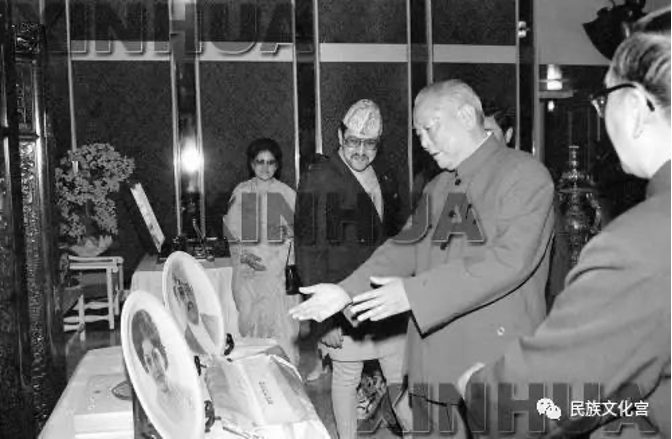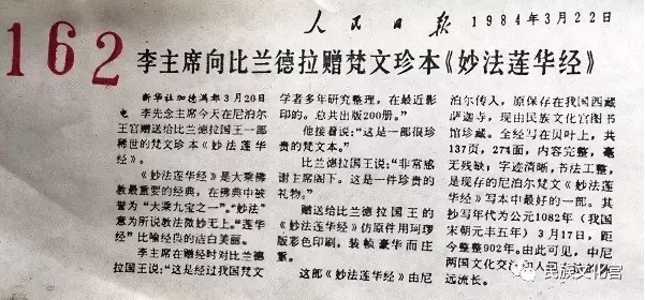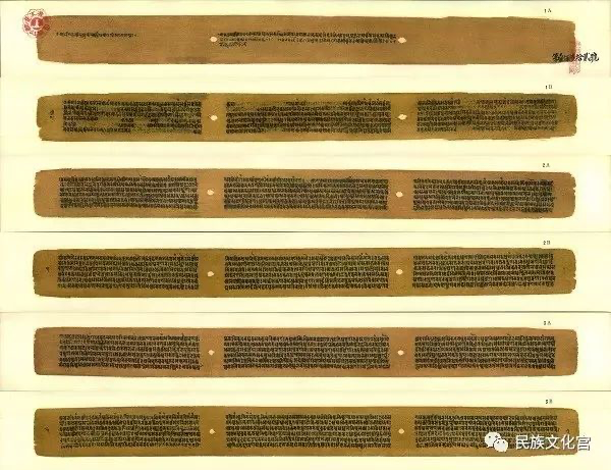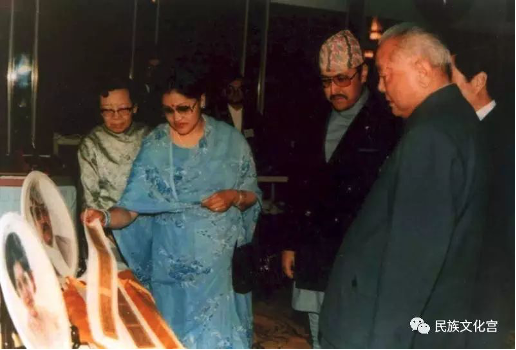
On March 20, 1984, President Li Xiannian visited Nepal and presented King Birendra with a photocopy of the palm-leaf manuscript of the Lotus Sutra. President Li remarked, "This represents the culmination of many years of research by Chinese Sanskrit scholars. It has been recently compiled, photocopied, and published, with a total of 200 volumes released. This is a very valuable Sanskrit text."
The Lotus Sutra comprises seven volumes and twenty-eight chapters, translated by Kumarajiva in the eighth year of Emperor Yao's reign (2356-2255 BCE). It serves as the foundational text for the establishment of the Tiantai Sect of Chinese Buddhism and the Nichiren Sect of Japan. As a collection of Mahayana teachings, this work holds a prestigious place within the Buddhist community. It is considered the most important classic of Mahayana Buddhism and is revered as "one of the Nine Treasures of Mahayana" in Buddhist scriptures. "Wonderful Dharma" refers to the profoundness of the teachings, while "Lotus Sutra" metaphorically represents the purity and beauty of the scripture.
The Sanskrit palm-leaf manuscript of the Lotus Sutra, collected by the National Palace of Culture, was introduced to China from Nepal. It was written in March 1082 AD (the fifth year of Yuanfeng during the Song Dynasty) by the Thakuri Dynasty of Nuwakot, Nepal, during the reign of the last king, Shankaradev. This ancient manuscript, nearly a thousand years old, is written in Bhujinmol script. The entire sutra consists of 137 pages, or 274 sides, with each palm leaf measuring approximately 54 centimeters in length and 5 centimeters in width. The size of each leaf is nearly identical. The sutra is complete, with both the beginning and the end intact. The script is beautifully rendered, with a high degree of clarity.
Thanks to the efforts made by Ji Xianlin, a reputed Indologist and vice-President of Peking University, photocopying and publications of Lotus Sutra began in 1981 at the Cultural Palace of Nationalities. The photocopies replicated original palm-leaf manuscript and was printed in color. The event was of such an important significance that in September 27, 1983, the Cultural Palace of Nationalities, along with scholars from various academic circles, held a grand ceremony to commemorate the official publication of palm-leaf manuscript of the Sanskrit Lotus Sutra which is a testimony to China’s efforts on presrving the historical heritage and archives.
The release of photocopies of the palm-leaf manuscript of the Lotus Sutra not only holds significant reference value for research in cultural relics, Buddhist studies, and Indology but also provides valuable research material for academic circles both domestically and internationally. Moreover, it has gained widespread popularity and is exported globally. It is held in the collections of libraries in the United States, the United Kingdom, Japan, Germany, India, Mongolia, Nepal, and many other countries.
This photocopy of the palm-leaf manuscript of the Lotus Sutra, a national gift, was compiled, edited, and published by the Chinese Ethnic Library at the Cultural Palace of Nationalities. The original manuscript was also held in the Chinese Ethnic Library at that time. It had even made it to the copies of People’s Daily as a rare gift presented to King Birendra.

This is a summarized version of the article that can be found here





